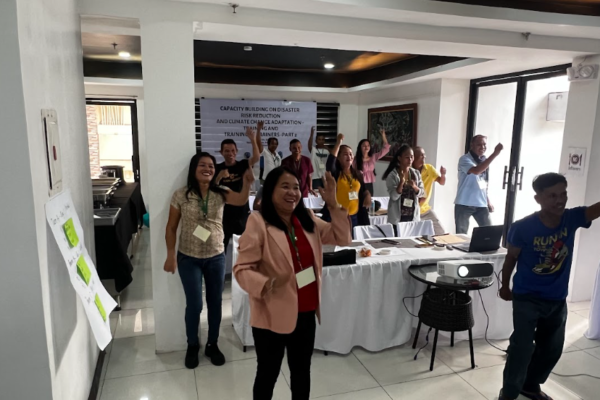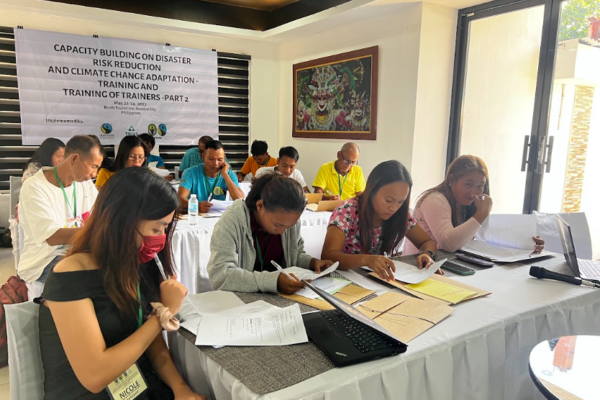Climate change-induced disaster risks have been identified during the survey conducted by Fairtrade NAPP as the primary risk with the most significant impact on Small Producers’ Organizations (SPOs). These risks were identified as the most significant threat to the well-being and livelihoods of small producers, emphasizing the growing need for support and interventions to promote climate resilience practices among SPOs.
Following the success of round 1, round 2 of the “Capacity building on disaster risk reduction and climate change adaptation training and training of trainers” program was organized by the Fairtrade NAPP and Fairtrade Producers Network (FTPN) in partnership with TRIAS SEA. The 3-day event was attended by 20 representatives of targeted 8 Small Producer Organizations in the Philippines. The event aimed to continue their work in enhancing the knowledge and skills of participants in addressing the challenges posed by climate change and facilitating feasible solutions across the agriculture sector.

The first day commenced with a welcome address from Sandrico Cornelio, chairperson of FTPN. The importance of the training in relation to climate change vulnerabilities in the agricultural sector was specifically emphasized. Fairtrade NAPP shared the objectives and three parts of the Trainers of the Training session. TRIAS’ team provided a comprehensive introduction to Disaster Risk Reduction and Climate Change Adaptation principles, covering topics such as weather, climate, climate change, and the risk formula. The team emphasized coping mechanisms, adaptation, and the importance of opportunities for change and increasing capacity. They summarized the role of a trainer/facilitator and the principles of adult learning. The qualities, knowledge, and skills of a trainer/facilitator were also highlighted. The day ended with preparations for presentations and a practicum in two clusters, involving various teams such as DAFWARBA, MACFWA, NAPWA, NAPFWA, PIBFA, MERFIA, FTPN, and FFCC.
On the second day, the emphasis was placed on practical activities and informative presentations. The participants were split into two clusters, with one engaging in practical exercises within the function hall, while the other ventured outside for their practicum experience. Each participant was assigned a specific topic to present. Feedback and comments from participants were encouraged after each presentation. The presentations covered various topics such as climate change, climate variability, hazards, vulnerability, risk assessment, livelihood processes, and adaptation. In Cluster 1, the team delved into the various aspects of climate change, addressing topics such as climate vulnerability and its impact on farming practices. Engaging presentations were given, accompanied by valuable feedback to enhance comprehension and delivery. Suggestions were offered to improve familiarity with the content, boost self-confidence, and maximize voice projection. The team displayed a genuine commitment to deepening their understanding of climate change and its implications, ensuring they can effectively convey this crucial information to others. In Cluster 2, the team underwent a facilitated session led by Elvie, who provided guidance on the practicum’s structure. Assigned topics were presented, followed by valuable feedback from participants. Suggestions included improving PowerPoint slides, engaging the audience, utilizing interactive tools, and incorporating illustrations. The team recognized the importance of familiarizing themselves with the content, delivering clear presentations, and undergoing comprehensive training. They expressed gratitude for the learning experience and emphasized the need for effective communication when sharing knowledge with others. These activities emphasized the importance of familiarity with the topic, effective delivery, and self-confidence.

On the final day, the day began with a vitalizing Zumba to engage everyone. Cluster 2 continued its practicum with presentations on the feasibility of adaptation options and the required adaptive capacities. Participants shared their feedback, highlighting language barriers and the need for clear communication. The organizers discussed the assessment of becoming an effective trainer and conducted a post-test. The participants were then tasked with creating their own rollout plans for their respective associations. This exercise helped participants to apply the knowledge and skills gained throughout the training.
The day ended with The Training for Trainers program on Disaster Risk Reduction and Climate Change Adaptation provided participants with valuable insights and practical experience in addressing climate change challenges in the agriculture sector. The sessions emphasized the importance of familiarizing oneself with the topic, effective delivery, and developing self-confidence as a trainer/facilitator. The presentations and feedback sessions allowed participants to learn from one another and improve their skills. The creation of rollout plans further encouraged participants to apply their newfound knowledge and contribute to climate change adaptation efforts in their respective communities. Hence, producer organizations can ultimately contribute to a fairer and more sustainable economic system that is climate change adaptive and sustainable.








